Australian Tour 2004.
It was not difficult to choose a holiday destination. The last 2 years we had a wonderful time in Australia, and the continent is that big, that for many years to come we can travel there.
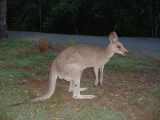 We booked a trip at short notice, at Pacificislandtravel.nl as we did the last years.
We booked a trip at short notice, at Pacificislandtravel.nl as we did the last years.
We have only 4 fixed elements in the travel plan: the trip to Australia, the 2 nights in Sydney, the pickup and drop off of the camper and the flight back.
Further we are free, but we plan to visit opal mines in Lightning Ridge and dive the Great Barrier Reef.
Anything else we would decide en route.
We were flying United Airlines, through the USA. It is the longer part around the globe, but perfect connections, and good to collect air miles!
It took us 3 trips, Amsterdam-Washington, 8 hours, and then 5 hours to San Francisco and the last leg, 14 hours to Sydney. As we flew west, the daytime was long. We landed in the dark in San Francisco, and before midnight we did take off. Most of the trip was in a long, moonlit night.
Here is the sunrise, flying near Australia The sunlight hits the air high in the stratosphere, while the earth is still dark.
When we passed the equator a violent turbulence did shake the airplane like a leave. It reminded me flying F-16 at low level, high speed over mountains, in stormy weather. The trip was long, too long. The seat pitch of the economy class of United Air lines might be OK for a pygmy, but not for a normal person of 1.90m.
Every few hours some exercise was required to survive.
Sydney was nice, sunny and warm. We planned to visit Sydney for two days. The first day we walked a few hours through the centre and parks. But when the hotel room was ready, we were worn out by the long flight and the jetlag. So we decided to take a short nap, which lasted however 17 hours.....
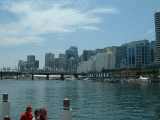
Sydney is a well maintained and organised big town. Four million people are living there. Sky scrapers dwarf the few colonial buildings which remained. The skyline is impressive. The town looks very well maintained and tidy.
We decided to go to the harbour with the famous Opera House and the huge Harbour bridge. It's lovely to spend your time there as a tourist.
We saw a military ceremony, attended by many veterans, in front of the townhall. 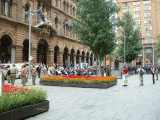
Apart from the Aussies, we met in the past, we know only one family living in Australia, who we met before. That is General Lajos Fodor, the former Hungarian Chief of Defence. We had a good relationship with him during our assignment as diplomat in Budapest. He is now accredited to Canberra as Ambassador. And guess who we -just by coincidence- met in the harbour of Sydney, 500 kms from Canberra? Yes, Ambassador Lajos Fodor, A chance of one in a billion? A needle in a haystack? No, the chance was much, much smaller! We had a nice talk and, as we did not plan to go to Canberra as we were there before, we decided to exchange emails.
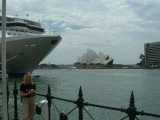 In the harbour was a giant cruise ship, dominating the view.
In the harbour was a giant cruise ship, dominating the view.
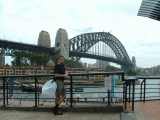
The bridge, connecting the north and south part of Sydney, is massive and towers high over the surroundings.
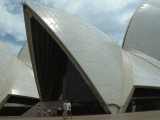 Close to the bridge, on the end of a peninsula is the icon of Sydney, the Opera House. It is unique shaped indeed, but very impractical. But the building is too small for an opera. It is a conglomerate of similar distinctive buildings with different dimensions, all like a vertical white shell. Apparently built from the best materials, but 30 years take their toll. The building is highlight in architectural history indeed.
Close to the bridge, on the end of a peninsula is the icon of Sydney, the Opera House. It is unique shaped indeed, but very impractical. But the building is too small for an opera. It is a conglomerate of similar distinctive buildings with different dimensions, all like a vertical white shell. Apparently built from the best materials, but 30 years take their toll. The building is highlight in architectural history indeed.
Here a view from the Sydney Opera to the town.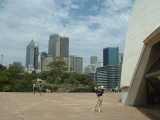
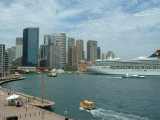 The harbour is an interesting area, vistited by many.
The harbour is an interesting area, vistited by many.
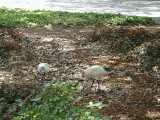 Adjacent to the Opera House, is the Botanic Garden, very interesting. An enormous variety of plants and trees can be seen, the climate allows for almost any species. Tropical species are exhibited in a nice green house. Most plants are good described and much background information is available, so it's a good opportunity to refresh the study biology.
We were greeted by two Australian White Ibis Threskiornis molucca.You see them often. It is a large, white wading bird with a naked, black neck and it has a long, downcurved bill.
Adjacent to the Opera House, is the Botanic Garden, very interesting. An enormous variety of plants and trees can be seen, the climate allows for almost any species. Tropical species are exhibited in a nice green house. Most plants are good described and much background information is available, so it's a good opportunity to refresh the study biology.
We were greeted by two Australian White Ibis Threskiornis molucca.You see them often. It is a large, white wading bird with a naked, black neck and it has a long, downcurved bill.
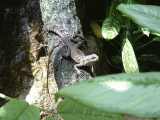 A curious salamander is looking at us.
A curious salamander is looking at us.
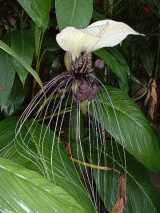 We see beautiful flowers blooming.What we see as well is a young Wollemie Pine. This is an amazing tree. In fossils found everywhere on the globe, but thought to be extinct. Only 10 years ago the pine was discovered in a cove, in the Wollemie National Park, only 100km from Sydney. This absolutely unique tree is protected by bars.
We see beautiful flowers blooming.What we see as well is a young Wollemie Pine. This is an amazing tree. In fossils found everywhere on the globe, but thought to be extinct. Only 10 years ago the pine was discovered in a cove, in the Wollemie National Park, only 100km from Sydney. This absolutely unique tree is protected by bars.
 Many big spiders could be seen, weaving very strong 3-dimensional webs.
Many big spiders could be seen, weaving very strong 3-dimensional webs.
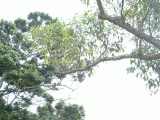 To our delight we see a laughing Kookaburra. An amazing bird, you hear them every morning. The call is a chuckling and a loud "laughing", often made by a group. But you see them seldom. It is a medium size bird, large kingfisher, it has a short neck and looks sturdy.
To our delight we see a laughing Kookaburra. An amazing bird, you hear them every morning. The call is a chuckling and a loud "laughing", often made by a group. But you see them seldom. It is a medium size bird, large kingfisher, it has a short neck and looks sturdy.
You see the Kookaburra in the centre of the picture.
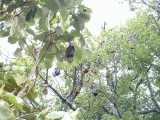
Many interesting birds live there and flying foxes, big bats, are upside town hanging in some trees in big groups. They are noisy and teasing each other. In the night they go hunting.
A succulent garden showed many varieties from all over the world.
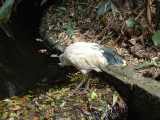 We come close again near a white Ibis. This animal is here not too shy.
We come close again near a white Ibis. This animal is here not too shy.
It was a few well spend days, to see Sydney and to recover from the jet-lag.
As expected we woke up early, so we had an early taxi ride to pick up the camper.
Kea Campers had everything well organised and after insisting that we did not want an insurance and so took the full liability for 5000$, we left for the west, direction Blue Mountains.
This is one of the nicest parts of Australia, but as we visited that 2 years before, we just crossed the Great Dividing Range. The pass was at 1000m high. When descending down again we got a nice view over the Blue Mountains.
It was hot and only with the air-conditioning at maximum you could survive. We passed along a power station and visited it.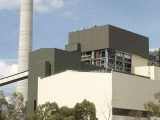 It was fired by coal, mined directly near the power station. The coal seams are 300m deep, thick and high quality, with a low sulphur content. The coal is blown as fine powder is the heater. Two generators of each 660 Mw supply the power. It is a high technology power station, but the management is well aware of the environmental impacts and try to cope with that. The company has 4 power stations and supplies 20% of the liberalised Australian power market. An exhibition showed that alternative power sources like wind, sun and biomass, how sympathetic they may be, only can fulfil a minimal role in the power generation based on the present demand.
It was fired by coal, mined directly near the power station. The coal seams are 300m deep, thick and high quality, with a low sulphur content. The coal is blown as fine powder is the heater. Two generators of each 660 Mw supply the power. It is a high technology power station, but the management is well aware of the environmental impacts and try to cope with that. The company has 4 power stations and supplies 20% of the liberalised Australian power market. An exhibition showed that alternative power sources like wind, sun and biomass, how sympathetic they may be, only can fulfil a minimal role in the power generation based on the present demand.
Australia is by far the largest exporter of coal in the world. There are still huge unexploited coal basins, some just under the surface.
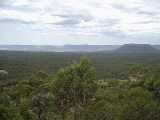 From the eastern side of the Gread Dividing ridge, we have a nice view over the Blue Mountains. They are called that way, as a blue haze is visible, due to the eucalyptus trees which emit their fragrance. It smells nice and fresh.
From the eastern side of the Gread Dividing ridge, we have a nice view over the Blue Mountains. They are called that way, as a blue haze is visible, due to the eucalyptus trees which emit their fragrance. It smells nice and fresh.
 It was hot, very hot. At he end of the day, when the temperature dropped to 36 degrees, we halted at a lake, with a camping. Next morning very early, we made our first run along the shore. No need to say that it was heavy at these high temperatures, but a good exercise to get the blood pumping again. We run every day, 5 - 10 kms. It's our addiction and we need it.
It was hot, very hot. At he end of the day, when the temperature dropped to 36 degrees, we halted at a lake, with a camping. Next morning very early, we made our first run along the shore. No need to say that it was heavy at these high temperatures, but a good exercise to get the blood pumping again. We run every day, 5 - 10 kms. It's our addiction and we need it.
We decided that, in this temperature, it was a good plan to have the alarm clock at 5, so more time to see nice things.
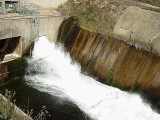 When we left the lake camping, we visited the dam, which forms the lake.
When we left the lake camping, we visited the dam, which forms the lake.
The dam operator told us that his dam was part of a complex of more dams. The outflow of water is carefully metered.
Today he released 158.000.000 litres and that is used for agricultural purposes. Downstream the output of the valley is measured again and usual some 10% is not used and flows further. With some regret in his voice he noted that he had to deliver some 40% of 'his' water to another reservoir. The water is still not used for generating electricity, but at the end of the year he gets a generator. He told that the lake gets runoff water after 2 weeks of raining. First the soil soaks up the water and then the runs off to the lake. However, sometimes torrential rain occurs, delivering 200 mm in one day (equal to the average of 3 months in rainy Holland). Then the roads are flooded and much damage occurs.
It is an interesting business, that water management.
The water leaves the reservoir with a thundering roar. The energy is still not used.
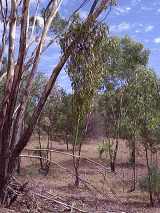 The lake is surrounded by dry eaucalyptus woodland. Eucalyptus is called gumtree in Australia.
The lake is surrounded by dry eaucalyptus woodland. Eucalyptus is called gumtree in Australia.
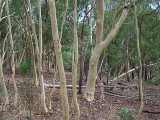 The hills around the lake had a kind of white gumtree (eucalyptus) which shed its bark till a golden layer shows.
The hills around the lake had a kind of white gumtree (eucalyptus) which shed its bark till a golden layer shows.
Sometimes this bark is eaten away by insects, making a nice pattern.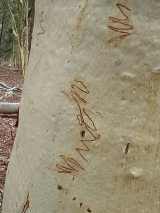
 Interesting is that a spillway, a wide overflow, was cut out of a mountain. The overflow is of course lower than the dam and protect is from preventing overflowing.
Interesting is that a spillway, a wide overflow, was cut out of a mountain. The overflow is of course lower than the dam and protect is from preventing overflowing.
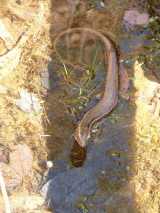 We saw near the outlet a curious salamander.
We saw near the outlet a curious salamander.
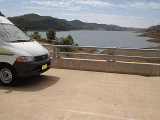 This is a picture with an oversight from one of the dams which created the lake.
This is a picture with an oversight from one of the dams which created the lake.
After the lake we went further north, on deserted roads, scattered were farms, many of them for sale. Some even deserted. Apparently rural life here is not too easy. The drought does now last for years. There used to be a 20 year cycle. A few years abundant rain, then slowly less and less, till the cycle starts again after some 20 years. However, this varies by region.
In Mudgee, a wine centre we buy a local wine, 3 times as expensive as a better Australian wine in Holland.
We spend the night at Gilgandra. In the night we visited the observatory. The Alpha Centaurus, the closest star to us, was good visible. Stunning was the Orion nebula, a double star and Venus. The rings of Saturn were so clearly visible that Birgitt asked if they projected a picture. It was an unforgettable experience.
Next morning it's cooler, 30º, we start our morning run early. We run 9 kms in a flat landscape. Thousands of parrots and cockatoos make a terrible noise. Most are grey with a red front, but many big white Sulphur crested cockatoos fly around as well. Some are joining the groups of red/greys.
If you ever wished to have a parrot in a cage, please come and see here how these magnificent agile flyers have fun together. They never should live in a cage.
Then we set course top the Warumbangol National Park. It has many steep mountains, former volcanos. The top consist often of vertical basalt rocks.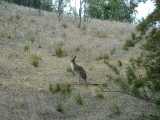 Here we saw our first kangaroo this trip.
Here we saw our first kangaroo this trip.
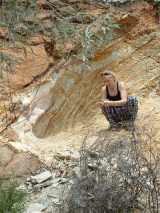 We entered the area and interesting was the layered stone in the hills, Soft white stone, layered with other colours till deep red.
We entered the area and interesting was the layered stone in the hills, Soft white stone, layered with other colours till deep red.
We see here the more kangaroos. Later we would see many.
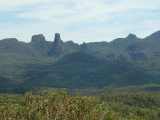
The scenery was impressive. Basalt peaks, the core of ancient volcanos, protruded out of the crest of hills. Long ago the area was much higher but in due course the upper layers disappeared.
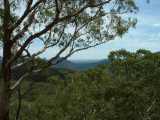
From the top of the hills we had a nice lookout, into the distant flat land.
This dry euclupt woodland, with White gum trees, with their shiny golden bark were the main trees here, with the narrow leaved Ironbark trees (Eucalyptus Cebra) and black cypress pine(Callitres Endlicheri) scattered between them. Ironbark is very durable. Good for railway sleepers and it is excelled firewood as well. In the open forest was an undergrowth of shrubs.
There were many places where the basalt core of the ancient volcanos was visible. At some places it formed giant knife-like formations.
 Suddenly we saw a big lizard sneaking away.
I followed the animal into the forest to make a picture, but he did not like that. He tried to escape in a tree. He was big, almost than a meter long, with a meter long tail behind. He resembled a varan. Its big forked tongue flicked sometimes. What a beauty! He climbed higher and higher on a tree with a very smooth bark. He has very sharp claws.
Suddenly we saw a big lizard sneaking away.
I followed the animal into the forest to make a picture, but he did not like that. He tried to escape in a tree. He was big, almost than a meter long, with a meter long tail behind. He resembled a varan. Its big forked tongue flicked sometimes. What a beauty! He climbed higher and higher on a tree with a very smooth bark. He has very sharp claws.
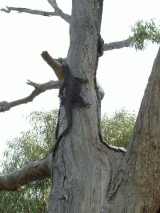 The lizard is called goanna (varanus varius), is the biggest lizard in Australia and quite interesting. It's a scavenger and eats nestling birds, as well as other tree-dwelling and ground animals and carrion. If he bites you, awful inflammations occur, due to the decaying food in his mouth.
The lizard is called goanna (varanus varius), is the biggest lizard in Australia and quite interesting. It's a scavenger and eats nestling birds, as well as other tree-dwelling and ground animals and carrion. If he bites you, awful inflammations occur, due to the decaying food in his mouth.
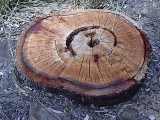 We see a fresh cut tree stump and interesting is that the tree suffered from a fire, many years ago. This caused a black ring. In the centre of the tree thosetraces of a forest fire could be noticed. The tree survived and flourished until cut. The trees grow slowly and the wood is hard.
We see a fresh cut tree stump and interesting is that the tree suffered from a fire, many years ago. This caused a black ring. In the centre of the tree thosetraces of a forest fire could be noticed. The tree survived and flourished until cut. The trees grow slowly and the wood is hard.
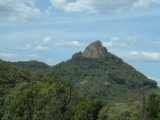 The view of the many old vulcanoes is interesting. Usually the core of basalt or lava is visible at the top.
The view of the many old vulcanoes is interesting. Usually the core of basalt or lava is visible at the top.
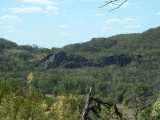 Sometimes the core is visible on the side of the volcano. This forms six sided pillars, if he hot lava did cool off slowly.
Sometimes the core is visible on the side of the volcano. This forms six sided pillars, if he hot lava did cool off slowly.
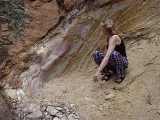 Everywhere strange forms and colors can be seen in the hillsides. The red can be very intense ocher red coloured.
Everywhere strange forms and colors can be seen in the hillsides. The red can be very intense ocher red coloured.
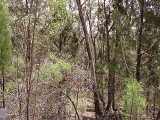 Though Australia may look green, virtually every original Australian tree or shrub is different from what we see in Europe. Sometimes you have species imported from other countries.
Though Australia may look green, virtually every original Australian tree or shrub is different from what we see in Europe. Sometimes you have species imported from other countries.
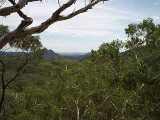 From the top of a mountain we have a brilliant view over the National Park, with the flatland visible on the horizon.
From the top of a mountain we have a brilliant view over the National Park, with the flatland visible on the horizon.
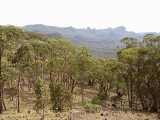 The forest here is rather thin and consist mostly of white Gum and Ironbark.
The forest here is rather thin and consist mostly of white Gum and Ironbark.
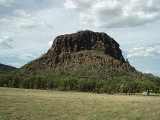 At one place a nice symetric core of a volcano was visible.
At one place a nice symetric core of a volcano was visible.
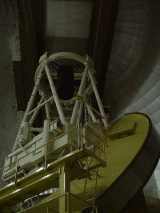 We visited the Anglo Australian Observatory called Siding Spring. About thirty years ago, it was the biggest on the southern hemisphere. They did resolve many mysteries in Universe and are now specialised in researching the 1987A Supernova. We could make a picture behind a glass window. The telescope with a 3,6m diameter mirror is giant indeed. An associated exposition has stunning pictures and lots of information about galaxies, quasars and so on. It was so interesting that we decided to visit the Australian radio telescope in Narrabri as well.
We visited the Anglo Australian Observatory called Siding Spring. About thirty years ago, it was the biggest on the southern hemisphere. They did resolve many mysteries in Universe and are now specialised in researching the 1987A Supernova. We could make a picture behind a glass window. The telescope with a 3,6m diameter mirror is giant indeed. An associated exposition has stunning pictures and lots of information about galaxies, quasars and so on. It was so interesting that we decided to visit the Australian radio telescope in Narrabri as well.
This morning we set the alarm clock at 5, so we had more time for our program, including running. During the run we collected seeds of a multiflora, mini sunflower. You will see those sunflowers in our garden in Hungary. In the mean time we collected seeds from delicious melon, pumpkins and some strange trees.
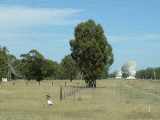 The Australian Telescope not only consists of a radio telescope, but of six other instruments, mainly for research on the sun. It is the largest and most powerful radio telescope array in the Southern Hemisphere.
The Australian Telescope not only consists of a radio telescope, but of six other instruments, mainly for research on the sun. It is the largest and most powerful radio telescope array in the Southern Hemisphere.
At the observatory there are 5 huge antennas that can be moved along a 3 km track in a east-west direction and also along a 30m north-south track. A 6the antenna is situated a further 3 km west of the main track. Using this configuration, the combined power of the antennas can simulate a single 'dish' 6 km in diameter.
The exposition was excellent again and we are now fully updated on the recent developments on astronomy. The exposition was nicely complementary to that of the Siding Spring Observatory. This was centred about Supernovae, pulsars, black holes and quasars. A quasar radiates more energy than 100 normal galaxies (each may contain a million times a billion stars. This bright, star like sources, may be the farthest objects yet detected in universe.
The universe is so enormous gigantic that it is beyond understanding. It is calculated there are much more stars, most of hem even with planets, than grains of sand on earth!
It was hot, very hot. According to the radio 45ºC could be expected, but it felt much hotter. More of a problem were the aggressive flies. They are smaller than the European ones, but very persistent. The sometimes fly in your ears and nose and if it is very hot, they try to drink from the fluid of your eyes, if you have no sunglasses. Doing that they are not easy chased away, so you conveniently can push them dead, leaving a mess.
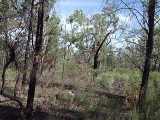 North of Narribri we see a forest, damaged by fire a few years ago. Now you can see that some big trees have survived the fire, and that many other trees did sprout. So the forest are renewed by the fire. It is natural process
North of Narribri we see a forest, damaged by fire a few years ago. Now you can see that some big trees have survived the fire, and that many other trees did sprout. So the forest are renewed by the fire. It is natural process
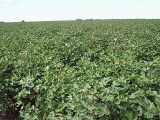 The hot climate is excellent for cotton and Australia is one of the major cotton exporters in the world. In fact the value of export exceeds that of wool. The large scale industry is only 30 years old. Long ago however cotton was planted on a small scale. The cotton industry is a hi-tech industry and the growers are supported by the industrial infrastructure to process the cotton The Australian cotton is high-quality, for the finest products and 96% is exported. It is however controversial, due to the abundant use of pesticides and water. In the Australian Cotton Institute we were informed about the production cycle. We collected some seeds, so now we can grow now the cotton in Hungary from professional seeds.
The hot climate is excellent for cotton and Australia is one of the major cotton exporters in the world. In fact the value of export exceeds that of wool. The large scale industry is only 30 years old. Long ago however cotton was planted on a small scale. The cotton industry is a hi-tech industry and the growers are supported by the industrial infrastructure to process the cotton The Australian cotton is high-quality, for the finest products and 96% is exported. It is however controversial, due to the abundant use of pesticides and water. In the Australian Cotton Institute we were informed about the production cycle. We collected some seeds, so now we can grow now the cotton in Hungary from professional seeds.
Cotton suffers from many pests and genetically engineered seeds are part of a solution. By planting other crops near the cotton, the pests can be minimised. Indeed, we saw just along the main roads some nice examples of that. That looks good, but we inspected the huge cotton fields and saw only monocultures. So the mixed crops are good for the image but impractical, as the huge combined harvesters need big areas to work efficiently.
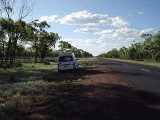 This is a typical road, leading to the Outback. Wide and with the Australian red soil on the sides. Just before we collected seeds of an amazing plant which flowers nice and can live on the barren red soil.
This is a typical road, leading to the Outback. Wide and with the Australian red soil on the sides. Just before we collected seeds of an amazing plant which flowers nice and can live on the barren red soil.
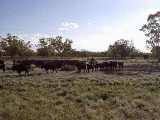 North of Dubbo a herd cattle blocks the road. The herds are guided by cowboys on horses.
North of Dubbo a herd cattle blocks the road. The herds are guided by cowboys on horses.
Next destination was Lightning Ridge, where the worlds most rare and precious opals, the Black Opals, are found. Opals are very popular due to the variety in colours, effect and shape. After getting some information it appeared possible to get a tour around the opal fields. And maybe you had the possibility to scratch in a heap of dirt for chips of opals. The active mines were of course out of bounds. Top quality opals yield 25.000 dollar per carat and so strangers are kept at a safe distance. We were warned never enter a claim uninvited, as this is considered trespassing. So we tried another strategy. We had a chat with a miner and his wife and after a few hours chatting we were invited in their mine. After a rough ride over unpaved roads we arrived at the mine and the process was explained. The opal is found in seams or pockets.
To find them, deep underground corridors were digged out. The dirt was then washed in a modified cement mixer and flushed with water. The remaining stones were all checked for opals. The stones were selected, cut and polished and sold to traders and anyone who would buy opals.
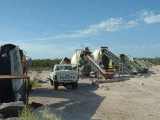 Many washing installations, here called agitators or Aggies, are in a row, on a dike. From a lake down the dike, the water is pumped into the machine.
Many washing installations, here called agitators or Aggies, are in a row, on a dike. From a lake down the dike, the water is pumped into the machine.
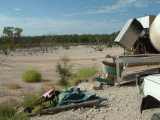 The mud leaves the machine to the other side in a kind of mud lake. This is slowly filling up with the pale white mud. This waste mud proved to be excellent for pottery.
The mud leaves the machine to the other side in a kind of mud lake. This is slowly filling up with the pale white mud. This waste mud proved to be excellent for pottery.
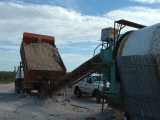 The truckload of excavated opalbearing ground is transported by truck to the Aggie and with a rubber transport system fed into the Aggie
The truckload of excavated opalbearing ground is transported by truck to the Aggie and with a rubber transport system fed into the Aggie
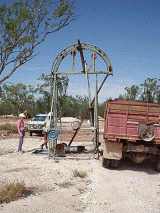
We descended into the mine through a shaft standing on the barrel of the automatic hoist. This is a primitive and risky kit, without any safety device.
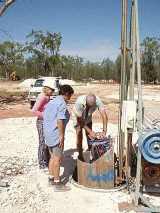
We descended more than 15 meter in the narrow, 90cm wide shaft. First the equipment was loaded in the barrel and George was standing on it.
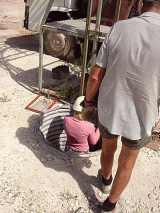 Then it was Birgitts turn, she descended with shaking knees deep into the earth.
We entered the mine by standing on a grid in the barrel and descended quickly the 15 meters down.
Then it was Birgitts turn, she descended with shaking knees deep into the earth.
We entered the mine by standing on a grid in the barrel and descended quickly the 15 meters down.
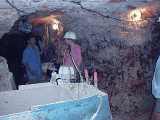 First was explained how the operations of this day would go, all of us got a task.
First was explained how the operations of this day would go, all of us got a task.
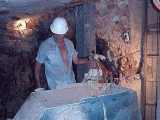 Then the "bogger" was made operational.
Then the "bogger" was made operational.
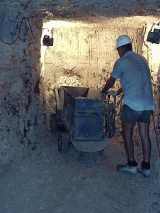 First the heap of the day before was transported to the hoist.
First the heap of the day before was transported to the hoist.
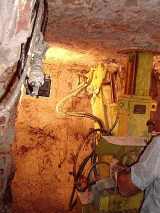 The tunnels down were about 2m high and 2m wide. At dangerous places the tunnels were propped with upright logs of local Black cypress pines. The temperature down there was pleasant and it was moist. The operation underground is supported by a 25 kW generator, standing by the side of the shaft. The digging is done with the 'digger', an electric/hydraulic machine with a digging claw. The dirt is scooped and transported by the 'bogger', a small vehicle, electrical/hydraulically operated as well. George starts to dig and transport the heap of opal bearing ground to the hoist.
The tunnels down were about 2m high and 2m wide. At dangerous places the tunnels were propped with upright logs of local Black cypress pines. The temperature down there was pleasant and it was moist. The operation underground is supported by a 25 kW generator, standing by the side of the shaft. The digging is done with the 'digger', an electric/hydraulic machine with a digging claw. The dirt is scooped and transported by the 'bogger', a small vehicle, electrical/hydraulically operated as well. George starts to dig and transport the heap of opal bearing ground to the hoist.
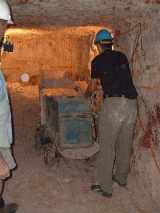 I was asked to operate the bogger and that was great fun. You control it like a tank on tracks, with hydraulic switch levers. The dirt is dumped in the same barrel we used to descend in the mine. This drum is automatically hoisted and in a semicircular end track emptied in a truck. If full, the truck transports the wash to the washing installation. The capacity to process the wash is incredibly much higher than the manual operation of not too long ago. With the help of all that equipment, in one hour and by one man, probably more earth is moved and processed than formerly in a week. But it cost quite a lot diesel fuel to operate it all. And it required an investment of about 100.000 dollars. The lease of a claim is not that expensive, about 150 dollars a year, and must be renewed yearly.
I was asked to operate the bogger and that was great fun. You control it like a tank on tracks, with hydraulic switch levers. The dirt is dumped in the same barrel we used to descend in the mine. This drum is automatically hoisted and in a semicircular end track emptied in a truck. If full, the truck transports the wash to the washing installation. The capacity to process the wash is incredibly much higher than the manual operation of not too long ago. With the help of all that equipment, in one hour and by one man, probably more earth is moved and processed than formerly in a week. But it cost quite a lot diesel fuel to operate it all. And it required an investment of about 100.000 dollars. The lease of a claim is not that expensive, about 150 dollars a year, and must be renewed yearly.
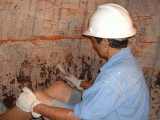 We spend all day underground and enjoyed the cool temperature. And no flies! We found some opal chips, fossils and potch. Potch are opals without colour. It is rather dangerous, sometimes the mines colaps and most fatalities happened in this claim area. The plan for the digging now was a further dig to the estimated position of the opals. Another 2 days digging was probably required to arrive at the position where the opal pockets might be. It was good visible that we did cut now through an area where a hot spot has been. This is required to give the opals colour, but too much heat melts them down. This was good visible here.
Here we are checking carefully the wall, instructed by Denise. We find many "angelstone" who are associated with opals.
We spend all day underground and enjoyed the cool temperature. And no flies! We found some opal chips, fossils and potch. Potch are opals without colour. It is rather dangerous, sometimes the mines colaps and most fatalities happened in this claim area. The plan for the digging now was a further dig to the estimated position of the opals. Another 2 days digging was probably required to arrive at the position where the opal pockets might be. It was good visible that we did cut now through an area where a hot spot has been. This is required to give the opals colour, but too much heat melts them down. This was good visible here.
Here we are checking carefully the wall, instructed by Denise. We find many "angelstone" who are associated with opals.
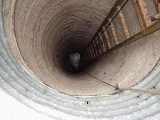 This day we burned some 50 litres diesel without finding a significant, precious opal. But we found lots of smaller opals and potch, this are opals without colour. You can be rich very quickly if you have a 'strike', but the miners must have the resources to survive the periods without success. There is no school for miners; you have to learn it yourself through trial and error. Experienced miners have no interest to make you wiser about opal mining.
This day we burned some 50 litres diesel without finding a significant, precious opal. But we found lots of smaller opals and potch, this are opals without colour. You can be rich very quickly if you have a 'strike', but the miners must have the resources to survive the periods without success. There is no school for miners; you have to learn it yourself through trial and error. Experienced miners have no interest to make you wiser about opal mining.
It is rather dangerous down there and George was willing to take us down on the condition he was not liable for anything. We agreed to that, but were very alert. Suddenly we heard a loud rumbling and everybody ran as fast as he could to the shaft. The reason was not clear until we were up. A thunderstorm was close. It stayed dry but it rained close to us. If a torrential rain occurs, the shaft is flushed with water and stones are raining down. You patiently have to wait then till it's over, at a safe place deep in the mine.
Here George is ascending out of the mine.
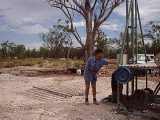 After the emergency evacuation we quickly leave the area. A thunderstorm is looming and the roads will be unaccessible if it rains.
After the emergency evacuation we quickly leave the area. A thunderstorm is looming and the roads will be unaccessible if it rains.
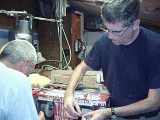 After returning to the campsite we cut and polished the opal we found.
After returning to the campsite we cut and polished the opal we found.
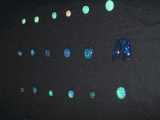 Here are some opals from the mine of George and Dense. There are a few very high quality gemstones. Here lies the equivalent of a house!
Here are some opals from the mine of George and Dense. There are a few very high quality gemstones. Here lies the equivalent of a house!
The opals are really nice and it is not to be seen on a picture, but every movement you make with the stone, makes it sparkle in various colors. The Lightning Ridge Black opal is the most precious of all. It is called black opal as it may me layered ona piece of black potch, that enhances the colour effects.
We decide to buy opals and we spend more to opals from George for more than the ticket to Australia. And we continue shopping in other shops!
We experienced that fossicking (the Australian word for hunting gemstones) is very addictive and had a wonderful time in the mine, we never forget it. Thank you, George and Denise.
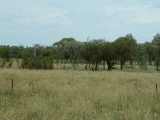 Every day the air heats further up and the weather forecast expects 45ºC today, but it feels hotter, A few times a day we take a dip in the swimming pool to cool off.
Every day the air heats further up and the weather forecast expects 45ºC today, but it feels hotter, A few times a day we take a dip in the swimming pool to cool off.
his night we sleep with a ventilator, which moves the air and this is a big improvement.
This day, Valentine Day, we are on opal shopping tour. We meet a young miner who still does not have the funding to mine with sophisticated equipment and does it by hand (the mining). His opals however are very nice and we buy 12 opals. It's difficult to stop buying and Birgitt is eager to collect more.
In the town we meet Hans, who just established his business and we buy another 9 Boulder opals. In the night we see again the collection of George and Denise and they have really showpieces. Expensive, but quality just has its price in life! We buy another 12 opals. Later we buy a few opalised fossils. No we have enough to start a shop in opals. But every gem is different and has its own character. So it's tempting to keep them all. In the meantime we bought opals for more than we spend to a trip to Australia.
To prevent we continue this buying frenzy, we leave in the morning (however, the plan is to go for other gem fields).
It was predicted that it would be hotter in the north, and they were right. Measured in the shadow, the thermometer reached quickly its maximum indication of 53 ºC, so it must be hotter, it indeed felt like in a sauna. If you picked up a stone or metal from the shadow, it burned in your hand so you could not hold it. The only place to survive that heat was driving in the car, with the air-conditioning at full capacity.
We drove carefully, a car is not built or these temperatures, some electronic functions did fail, like the remote controlled central locking. No Australians were visible; probably they were surviving before the air-conditioning. Just slowly walking was almost impossible. Remarkably, the area was still green as plenty rain has fallen a month ago. We see kangaroos and the giant emu birds. They will not have it easy to survive.
If you look under the trees oyu see the emu's. It were the first and last we saw this tour.
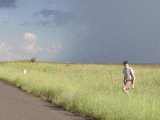 A surprise came in the evening, a short torrential thunderstorm appeared. After he passed, it was cooler, however for only a short time. Then it was hot again but now hot and damp.
A surprise came in the evening, a short torrential thunderstorm appeared. After he passed, it was cooler, however for only a short time. Then it was hot again but now hot and damp.
We are now in the Great Artesian Basin. It stretches from halfway the continent to the very north. Thousand meters below is the biggest freshwater aquifer in the world, containing trillion litres of water. If you drill a hole, hot water comes out. It seems to be very healthy and tastes fine. The water is 2 million years old. In fact you drink fossil water!!! We fill as much containers as we can with this gift of nature and slowly we revert from soft drinks to pure fossil water. In the camping the cold water, apparently directly connected to the hot artesian water well, is hot as well. The difference with normal water is that is feels somehow greasy while showering. The artesian water was wasted in the past. Now more conscious, the water is exploited with care, as it will not last forever. Half of the bores, yielding artesian water for many years are now dry.
In Lightning Ridge we buy a set of folding chairs, for half what the camper rental company charged for renting a set. We arrive in Roma and next morning is is slightly cooler. But if we return from our morning run, this time only a run of 35 minutes due to the high temperature, however, we sweat like animals.
The trip goes in the direction of the sapphire fields. The trip is very interesting and the landscape varies from lush green forest to a savannah type landscape. We see here a rare palm, the Zamia palm (Macrozamia moorei) 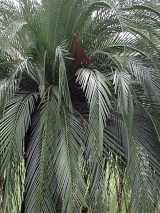 . This is the most majestic of the Australian native cycads. They have large leathery frond-like leaves that radiate from a central trunk. The leaves are deep green and sturdy. It may grow 2-8m high and may live to over 400 years. The pineapple-like seed cones on female plants are toxic, however the Aborigines have developed a method to remove the toxin, leaving a food that is rich in starch and protein. The food was available during the long dry winter when food was scarce.
. This is the most majestic of the Australian native cycads. They have large leathery frond-like leaves that radiate from a central trunk. The leaves are deep green and sturdy. It may grow 2-8m high and may live to over 400 years. The pineapple-like seed cones on female plants are toxic, however the Aborigines have developed a method to remove the toxin, leaving a food that is rich in starch and protein. The food was available during the long dry winter when food was scarce.
The trip is so nice that we have to refrain from stopping and photographing everywhere, as the plan is to go to the gemfields.
In the evening we see a remarkable phenomena: a tree loaded with dark brown and white butterflies. 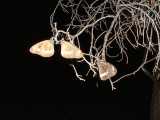 They try to sleep here
next to each other.
They try to sleep here
next to each other.
Since we got a ventilator on loan, we experienced that as a brilliant idea. In Roma we bought a entilator for inside the camper, and it is used almost continually. It gives a nice fresh breeze.
Today we did drive from Roma to Springsure, some 400 km. There seems to be here opalised wood and other treasures. We
ask the gas station owner some information and after he understands that we are really interested he shows us his collection. He tells that the nice pieces now are underground and it is really too hot for digging. We agree and we get as a present a nice piece opalised wood. Further he advised to look at the camping as sometimes people collect it, but leave it here as it is too heavy. And indeed, we found some nice stuff. This saves us a day digging.
Around us are thunderstorms looming. The radio warns of hailstone of 3 cm. These will wreck your car! And as we have no insurance that cover it, we are worried of course. In the night he activity is increasing, no second without multiple lightning strikes. Thunderstorms pass both sides of us and we get only rain and -lucky us- no hail.
The next morning we run again an hour. The heartbeat meter is an interesting tool to monitor the effort. In this high temperature it takes half an hour struggling till you get he 'runners high', that gives you the feeling you can run the marathon. In this phase the sustainable heart pulse is a nice 160 per minute. Though the heart pulse comes down quickly after the run, you still soak of transpiration some 20 minutes after. Then a shower and this marks the finest hour of the day.
There is abundant bird life in Surespring. Many kinds of parrots, cockatoos are flying around. The big white Sulphur-crested Cockatoo (cacatua galarita) is ever present with his squeaky call. It is a large cockatoo with a narrow yellow crest that is raises and fans when exited. Its plumage is mainly white with a yellow wash under the wings. The call is a harsh screeching.
After cooling down we set off to the north. At first we downloaded our emails in the village library of Springsure we are leaving for The Central Queensland Gemfields with telling names like Emerald, Rubyvale and Sapphire.
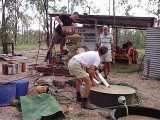 In Emerald the man from the information office tells us that Barry, the miner which who we developed such a friendly elationship 2 years ago, did quit the business.
In Emerald the man from the information office tells us that Barry, the miner which who we developed such a friendly elationship 2 years ago, did quit the business.
We went further to Rubyvale and looked for a possibility to buy sapphires. There were lots of shops, so we called at a wholesaler, an old man, who explained how the market was, nowadays. He had a nice collection of high-quality sapphires, He advised not to buy at the first shop but get a good picture of others.
So we stopped at another who appeared to be a miner. He was Jim Varak, a friendly man, Austrian who was here some 25 years. We bought blue sapphires from his own mine to complement the collection we bought 2 years ago here.
Then he invited us in his mine next day, to be there at 06.15. We can work there to select the sapphires and other precious stones. We will see how that goes and look forward for another nice and challenging day.
Well, we were there at 06.15 at the mine and we could start right the way. The process for mining is the following here. The seam containing sapphires is here some 7 meters below surface.
You descend down with a steel ladder. Down there the sapphire containing layer is drilled with a pneumatic drill. The material is manually put in metal buckets and hoisted to the surface. Then the material is fed in a slant tubular revolving sieve, which removes the sand. The remaining stones are collected in the buckets. Then the washing starts.
The machine is a kind of drum, with a flexible tire rubber bottom, operated by an electric motor, so it jitters. The stones are fed in through a funnel at the top and continuous the stones are jittered in the water.
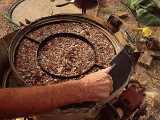 The relative heavy precious stones sink slowly down and the lighter stones are removed at the top.
The relative heavy precious stones sink slowly down and the lighter stones are removed at the top.
After feeding 13 buckets, each about 50kg, half a bucket remains containing ironstone (hematite) sapphires, zircons and so on.
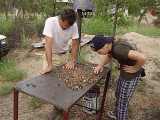 The bucket of washed stones is carefully assesed on sapphires and zircons on a table.
The bucket of washed stones is carefully assesed on sapphires and zircons on a table.
During the feeding o the machine the assessment of the yield was not too favourable.
But some 20 sapphires were found, many of them in gem quality.
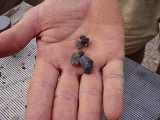 Then a big one, as big as a grape, was discovered. The sapphire looked grey from the outside, but was transparant. It was a parti color, a sapphire with many colours in it. The colours were so distributed, that a big yellow, green or blue stone could be cut from it, depending which parts were removed. A nice and precious stone indeed, and a 30 carat stone could be cut of it.
Then a big one, as big as a grape, was discovered. The sapphire looked grey from the outside, but was transparant. It was a parti color, a sapphire with many colours in it. The colours were so distributed, that a big yellow, green or blue stone could be cut from it, depending which parts were removed. A nice and precious stone indeed, and a 30 carat stone could be cut of it.
Worth a fortune!
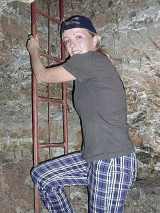 Birgitt descends here in the mine.
Birgitt descends here in the mine.
The mine is some 7 meters below and in a dry layer of stoney earth. The sapphire bearing layer is visible.
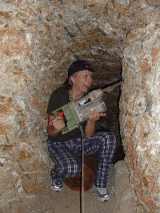 The walls are worked by a pneumatic drill. The sapphire bearing material is then shoveled in a metal bucket and hoisted with a manual winch to the surface for further processing.
The walls are worked by a pneumatic drill. The sapphire bearing material is then shoveled in a metal bucket and hoisted with a manual winch to the surface for further processing.
It is heavy and difficult work. And if you do not "strike" a precious stone, the rewards for this hard labour is marginal. But every miner hopes, he one day hits his fortune.
We met the former owner of the mine. A Dutchman, who emigrated in the fifties to Australia. We discovered that he spend his youth only 100m from my parents house in Arnhem, where I was raised. Small world!
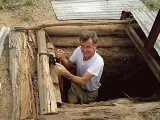 After hard work, and a tour in the mine, Jim Varak the owner and gem trader, climbs out of the mine.
After hard work, and a tour in the mine, Jim Varak the owner and gem trader, climbs out of the mine.
<
We went back to the shop and bought loads of sapphires. Then we did another try to wash a bucket of sapphire earth for ourselves and this time we found about a hundred sapphires and zircons, most small of course, but about five bigger and many gem quality.
With this catch we left for other gem fields and at Anaki we discovered a miner specialised in zircons. They are, due to the characteristics, brighter than sapphires, maybe even brighter than many diamonds. But they are not popular, as many people have heard of the synthetic Cubic Zirconias and mix them up with zircons. Still we bought a nice rose coloured for our collection. Indeed a brilliant gemstone.
This was a very special one. It came from central Australia, from the Harz Range. Only there that colour can be found and the field is now depleted. Only 40 kg raw stones are now at stock and it will yield only 2% high quality zircons. All the raw stones are in possession of the miner we met in Anaki.
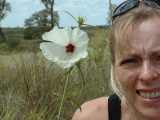 We collect seeds from interesting plants, usually beautiful lowers, hoping they will germinate in our garden.
We collect seeds from interesting plants, usually beautiful lowers, hoping they will germinate in our garden.
Then we set off to the north. The nature was still green and that was very unusual. We travelled to the coast through an area with many huge coal mines. These are producing mainly for export,
Today we cross the tropic of Capricorn to the north, which means that we are now in the tropics. Though we are closer to the equator, it's slightly less warm than in the south. We spend the night in Middlemount, where we found huge caravan park where most residents were the coalminers. (Warning sign: fighting patrons are removed from park). We are looking forward to reach the coast so we can treat ourselves on Fish and Chips.
In the morning, during our run we can see Middlemount. It is s very nice town, with an attractive layout, like in a park. It stretches over quite an area, as each house has a big garden. During the run we burned 550 kcal, according the computer. This morning the alarm clock did ring at 05.30, but we decided it is better to start earlier, so we can exploit the day better. As of now it will be 05.00, so we have more time for our program ;-) including running.
Today we drive to the coast for one of the major events of this tour, diving on the Great Barrier Reef, the biggest reef in the world. Today's target us Mackay one of the major cities in Queensland. As always, the landscape is interesting. It's all fresh green. It was a drought for many years, and as there was no food for the animals, they were slaughtered. Now there are hardly any cattle, but plenty of food, at least as long as it lasts.
Interesting to see how successful nature is in its survival strategy to survive the drought; one month after
the rain fell, all plants thrive.
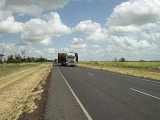 In this mining and agriculture area we see many transports of huge equipment
In this mining and agriculture area we see many transports of huge equipment
Suddenly we are effectively pushed of the road by an immense wide transport.
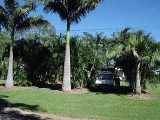 We pass the Great Dividing Range in easterly direction and suddenly the landscape changes: more friendly and even greener. Sugarcane is the main crop. The producers and factories are in troubles as the market price for sugar is less then 200 dollar per ton and nobody can make money at that price level. Over and above, sugar is excluded from the just concluded Free Trade Treaty with the USA, so the government is supposed to support the branch.
We pass the Great Dividing Range in easterly direction and suddenly the landscape changes: more friendly and even greener. Sugarcane is the main crop. The producers and factories are in troubles as the market price for sugar is less then 200 dollar per ton and nobody can make money at that price level. Over and above, sugar is excluded from the just concluded Free Trade Treaty with the USA, so the government is supposed to support the branch.
In Mackay we download our emails and check the dive pro. At this moment there are no trips to the Great Barrier Reef, so they advice us to go to Airliebeach.
At the coast we have at last a delicious Fish and Chips. We later hear that the fish in it usually is shark. It is then called "flakes". We see that often in fish shops.
We stop in St Helens and discover a wonderful camping, full of palms in every variety. Our campervan rests nicely protected from the hot sun under the palms.
We call a dive centre and we book a dive boat trip for the next day, 3 days and nights, in which 10 dives are scheduled.
We have to kill some time before we can board, and during a stroll in the town we see an opal merchant. His collection is very special and we cannot help It, but have to buy again 9 opals of a very special kind.
Swimming in tropical Queensland is risky. There are a few kinds of jellyfish on the coast, and if you hit one you may die, and if not it is probably the worst you ever experienced. One is the Chironex or Box jellyfish, a up to 30cm across and has up to 15 ribbon-like tentacles. This jellyfish delivers a severe and potentially life threatening sting. Stings from this jellyfish have been recorded predominantly in coastal area's.
A different one is a very small 1-2 cm, invisible jellyfish, with 4 small tentacles and called Irukandji. Although the sting causes only a minor stinging sensation, half an hour later however this is followed by severe generalised muscular pain, headache, vomiting and sweating. The sting of some species cause very high blood pressure that may be life-threatening.
You are only allowed to swim in a full lycra suit, a so called anti-sting suit. The person who sells diving trips insists that they go to area's without that dangerous jellyfish.
Then we can board the diving cruise. It is pretty full with young people, mainly backpackers and most of them with diving experience. A nice bunch of guys and girls, all divers.
Birgitt prefers to snorkel, a very exclusive position as she is the only one.
The Great Barrier Reef is the biggest reef in the world and stretches along the North East cost of Australia. Here it's more than 100 kms off the coast and during the night we cruised to our planned destination.
The boat had all the luxery you can expect from such an adventureful divetrip.
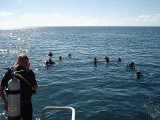 I decided to follow the PADI Advanced Open Water Diver course, which allows diving till 30 meters deep.
I decided to follow the PADI Advanced Open Water Diver course, which allows diving till 30 meters deep.
Here we jump in the water, to swim to the reef, about 100m from the boat. The reef is a vertical coral wall, full of aquatic life.
The diving program is great. Two dives in the morning, one in the afternoon and one night dive. At this location the water is not too clear. I loose my buddy a few times, as he has problems with the keeping up. Then we have to reunite at surface. I see that our daily running pays off, as my condition is second to none.
The fourth dive is the night dive, in pitch-dark. Like in a James Bond movie, the light beams of the divers pointing in the water and the mysterious alternate light source glowing on the air bottle. Strange creatures are coming out at night. Many emitting light and some even puffs of fluorescent stuff, like it burns. Coral is active at night and the polyps are waving their little tentacles in the stream. If you move your hand you see thousands of small light flashes of small plankton.
The food is very good and we are encouraged to drink as much as we like. It is hot again but the vessel, a modern 27m aluminium catamaran, is fully air-conditioned. On top is a sundeck, but in full sun it's unbearable there.
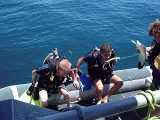 If the reef was far from the ship, you got a tenderride. You leave the raft sitting on the side, with a backward roll, altogether.
If the reef was far from the ship, you got a tenderride. You leave the raft sitting on the side, with a backward roll, altogether.
Next day was the deep dive, like the captain said 'now you can get legally drunk' due to the effect of nitrogen narcosis, a kind of intoxication by the nitrogen in the compressed air below 25m depths. Everybody feels it different.
I did not feel much effect. Of course it was colder and colours fainted to grey, except one piece of coral that still showed red, It's against the theory that colours will turn grey down there.
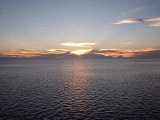 As often the sunset over the sea was a spectacular sight.
As often the sunset over the sea was a spectacular sight.
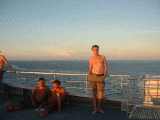 Lit by the last sunrays, we had a wonderful time on the sundeck. The temperature had now fallen from unbearable to very hot
Lit by the last sunrays, we had a wonderful time on the sundeck. The temperature had now fallen from unbearable to very hot
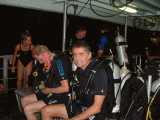 The next night we had the second night dive. We are preparing for another spectacular adventure
The next night we had the second night dive. We are preparing for another spectacular adventure
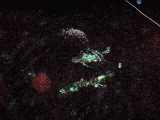 That night we had a spectacular performance at the backside of the ship. Attracted by the light, millions of small fishes were swirling in the water. This mass of fish attracted four huge 'Giant trevallies' who were feasting for hours on the fish. The big mouth open, they just swam through the little ones, who tried to escape by jumping out of the water. Many of them landed on the lowest deck and some worked themselves back in the water. It is remarkable that the little fish stayed together, so the frenzy continued all evening.
That night we had a spectacular performance at the backside of the ship. Attracted by the light, millions of small fishes were swirling in the water. This mass of fish attracted four huge 'Giant trevallies' who were feasting for hours on the fish. The big mouth open, they just swam through the little ones, who tried to escape by jumping out of the water. Many of them landed on the lowest deck and some worked themselves back in the water. It is remarkable that the little fish stayed together, so the frenzy continued all evening.
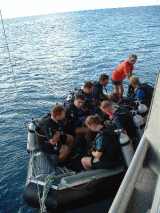 The diving became quickly a routine. Diving, resting a while, donning the suit for next dive and so on. Here goes the tender again.
The diving became quickly a routine. Diving, resting a while, donning the suit for next dive and so on. Here goes the tender again.
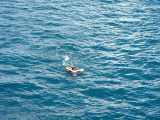 Swimming on the back goes easier and quicker.
Swimming on the back goes easier and quicker.
The trip included 10 dives, that means 4 dives per day, including two night dives. On my previous experience in the Red Sea, I thought 2 dives a day was a tough program!
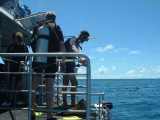 You carry lots of lead, to allow you to descend in the water. In my case some 7,5 kg. Added up with all the equipment, you carry quite a lot. But as soon you are in the water, you don't notice that anymore.
You carry lots of lead, to allow you to descend in the water. In my case some 7,5 kg. Added up with all the equipment, you carry quite a lot. But as soon you are in the water, you don't notice that anymore.
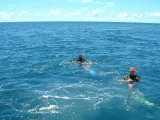 Here we go on another dive, together with my buddy Jack, a Danish traveller.
The last day only 2 dives were scheduled, as it takes the high-speed catamaran some 5 hours to travel back from the Great Barrier Reef to Airliebeach on the coast.
Here we go on another dive, together with my buddy Jack, a Danish traveller.
The last day only 2 dives were scheduled, as it takes the high-speed catamaran some 5 hours to travel back from the Great Barrier Reef to Airliebeach on the coast.
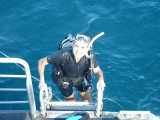 The subsequent planned dives the second day were naturalist dives, "peak performance buoyancy" dives and further just exploring the reef. You cannot get enough exploring this beautiful world.
The subsequent planned dives the second day were naturalist dives, "peak performance buoyancy" dives and further just exploring the reef. You cannot get enough exploring this beautiful world.
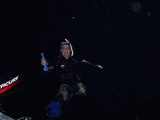 The last night dive was as spectacular as the first. This dive we did with he two of us. Nice squids with big reflecting eyes were visible. They changed of colour every few seconds.
The last night dive was as spectacular as the first. This dive we did with he two of us. Nice squids with big reflecting eyes were visible. They changed of colour every few seconds.
After every few dives, the boat moved to another location. 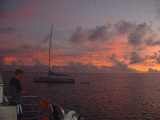 In the morning we woke up early and saw a sunrise with stunning colours.
Next to us a big sailing boat with snorkelers was anchored.
In the morning we woke up early and saw a sunrise with stunning colours.
Next to us a big sailing boat with snorkelers was anchored.
The last day dive was on the outer reef. 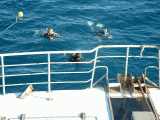 The first dive, most divers came enthusiastic out of the water shouting: 'Did you see the shark?' Well, it seemed I was the only one who did not see a shark.
The first dive, most divers came enthusiastic out of the water shouting: 'Did you see the shark?' Well, it seemed I was the only one who did not see a shark.
But the next dive I saw one, a real big White tip reef shark. It looked very big, mean and hungry, and probably might have been about one and halve meter. I could approach the shark closely, while it was hiding on the sand floor under a rock. In total 6 barracuda's were passing close.
Diving and snorkelling at the Great Barrier Reef is an awesome experience. Just underneath the water surface there is such an abundant life. Countless quantities of fish showed their magnificent colours and forms. Beautiful corals you cannot stop looking at it. Interesting is that there live almost exclusively animals. Coral looks like a plant but is an animal. Just a few patches seaweed can be seen. There are algae, but they live in symbioses with animals like coral and shells and perform the required photo synthesis.
You never forget the view other divers in front of a wall of spectacular formed and coloured coral, surrounded by many fish in stunning shape and colours.
And the water temperature was a nice 29 degrees. Sometimes you felt a light sting or even a bite which blooded. When you feel that, you hope it's not a jellyfish.
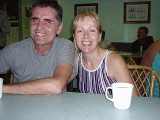 After the 10 dives we were glad that no incident took place. All divers happy and enjoying a great experience. The atmosphere on board was great. We will do this more. And the Advance course was completed, so the 30m deep certification is in! We enjoyed looking back to this wonderful experience.
After the 10 dives we were glad that no incident took place. All divers happy and enjoying a great experience. The atmosphere on board was great. We will do this more. And the Advance course was completed, so the 30m deep certification is in! We enjoyed looking back to this wonderful experience.
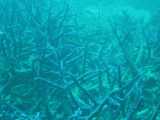 How did it look under the water? Just under the surface the colours are bright, but due to the characteristics of the propagation of visible light in water, the colours fade
away when you go deeper. If you light with a torch or flashlight the bright colours show at any depth. Here we see antler coral.
How did it look under the water? Just under the surface the colours are bright, but due to the characteristics of the propagation of visible light in water, the colours fade
away when you go deeper. If you light with a torch or flashlight the bright colours show at any depth. Here we see antler coral.
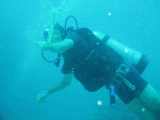 Here I'm floating around at about 10 meter deep. We were with a group of about 6 divers.
Here I'm floating around at about 10 meter deep. We were with a group of about 6 divers.
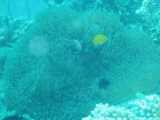 In the soft coral, anemones, live several kinds of fish. They protect each other. The yellow is an Pink Anemonefish.
In the soft coral, anemones, live several kinds of fish. They protect each other. The yellow is an Pink Anemonefish.
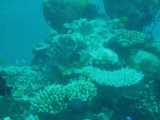 A nice combination of hard, reef building coral and spongues.
A nice combination of hard, reef building coral and spongues.
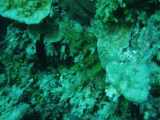 You seldom see plants, but here you see seeweed. Of course there are many algae. Left of centre a black angelfish.
You seldom see plants, but here you see seeweed. Of course there are many algae. Left of centre a black angelfish.
Here follow some magnificent pictures by Susanne from Berlin
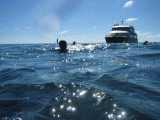 After surfacing you swim back to the Catamaran. I you see the boat
at the bow, it's OK as you slowly drift to the vessel. If you see the stern you usually have to swim against the
current.
After surfacing you swim back to the Catamaran. I you see the boat
at the bow, it's OK as you slowly drift to the vessel. If you see the stern you usually have to swim against the
current.
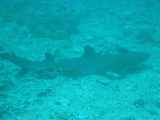 This White Tip Reef Shark is hiding itself on the bottom
This White Tip Reef Shark is hiding itself on the bottom
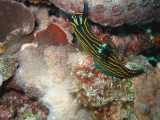 A nice coloured sea snail
A nice coloured sea snail
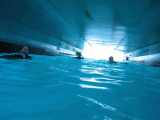 The most convenient way was to let you float in between the hulls of the catamaran. At the backside were the steps
where you could leave the water again.
The most convenient way was to let you float in between the hulls of the catamaran. At the backside were the steps
where you could leave the water again.
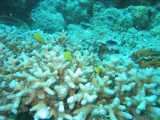 All kinds of fish live between the corals.
All kinds of fish live between the corals.
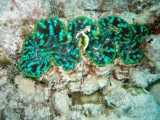 The bright coloured nudibranchs Gatropoda Nudibranchia is an amazing creature which floats over the corals. They
graze on sponges and cnidarians. These are soft- and hard corals and sea anemones
The bright coloured nudibranchs Gatropoda Nudibranchia is an amazing creature which floats over the corals. They
graze on sponges and cnidarians. These are soft- and hard corals and sea anemones
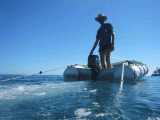 Diving 4 times a day can be rather exhausting and if you surface at a distance from the boat you are glad that the
tender is around to pull you back to the boat. Two ropes are hanging from the stern and you just cling to it.
Diving 4 times a day can be rather exhausting and if you surface at a distance from the boat you are glad that the
tender is around to pull you back to the boat. Two ropes are hanging from the stern and you just cling to it.
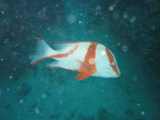 This beauty is the Red Emperor Lutjanus sebae He can grow till 1 meter. This fish is one of the reef species
whose flesh may carry a dangerous toxin. This is accumulated from feeding on invertebrates that have eaten infected
algae. This condition is called ciguatera and deepwater fishes are generally free of it. Usually bright coloured fishes
or invertebrates are dangerous or poisenous. A general rule is: ïf it is very pretty, or very ugly, or if it dos not
flee, don't touch it. It is always a good idea not to touch anything, as you may destroy creatures. Just enjoy it and
only leave the bubbles!
This beauty is the Red Emperor Lutjanus sebae He can grow till 1 meter. This fish is one of the reef species
whose flesh may carry a dangerous toxin. This is accumulated from feeding on invertebrates that have eaten infected
algae. This condition is called ciguatera and deepwater fishes are generally free of it. Usually bright coloured fishes
or invertebrates are dangerous or poisenous. A general rule is: ïf it is very pretty, or very ugly, or if it dos not
flee, don't touch it. It is always a good idea not to touch anything, as you may destroy creatures. Just enjoy it and
only leave the bubbles!
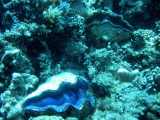 You see often bivalves. Here are two Giant Clams, Phylum Molusca Bivalva who can grow to 1,50 meter! Most feed
on plankton. The gills function both as breathing organs and to sort food into his mouth. A fleshy mantle covers the
the body and forms two siphons and a gill cavity. The mantle is bright blue.
You see often bivalves. Here are two Giant Clams, Phylum Molusca Bivalva who can grow to 1,50 meter! Most feed
on plankton. The gills function both as breathing organs and to sort food into his mouth. A fleshy mantle covers the
the body and forms two siphons and a gill cavity. The mantle is bright blue.
 The colonial polyps that form soft coral are protected by a fleshy mass strengthened by glassy spicules. Each polyp
has eight hollow tentacles around a central mouth. The polyps are connected to each other. Soft corals are filter feeders.
The polyps extend to feed on plankton.
The colonial polyps that form soft coral are protected by a fleshy mass strengthened by glassy spicules. Each polyp
has eight hollow tentacles around a central mouth. The polyps are connected to each other. Soft corals are filter feeders.
The polyps extend to feed on plankton.
 The corals in the reef form caves.
The corals in the reef form caves.
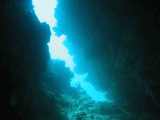 The reef building coral is a unique creature. If the sea floor slowly sinks, the coral
grows upward to the surface. The dead coral is compresses till it ends up as limestone. Eventually layers of more than 1000m
thick can be formed, massing even in mountains.
The reef building coral is a unique creature. If the sea floor slowly sinks, the coral
grows upward to the surface. The dead coral is compresses till it ends up as limestone. Eventually layers of more than 1000m
thick can be formed, massing even in mountains.
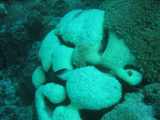 Incredible that this tiny creature really can form landmasses.
You can swim in the canyons formed by the coral. Many species of fish hide here in daytime.
Here are colonies of different kinds of corals living together.
Incredible that this tiny creature really can form landmasses.
You can swim in the canyons formed by the coral. Many species of fish hide here in daytime.
Here are colonies of different kinds of corals living together.
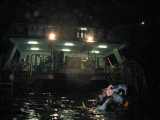 For the night dives the back of the boat is brightly lighted. You can see Birgitt on board, taking a picture.
For the night dives the back of the boat is brightly lighted. You can see Birgitt on board, taking a picture.
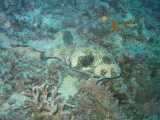 This is the porcupine fish Dicotylichtys sp.. It has an inflatable body to a size 3 times as big. The fish is
poisonous and eating means your sudden death.
This is the porcupine fish Dicotylichtys sp.. It has an inflatable body to a size 3 times as big. The fish is
poisonous and eating means your sudden death.
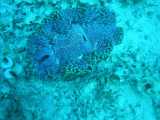 Here the blue mantle of the Giant Clam is good visible. Poachers sometimes try to catch them as the flesh is very valuable on
the black market.
Here the blue mantle of the Giant Clam is good visible. Poachers sometimes try to catch them as the flesh is very valuable on
the black market.
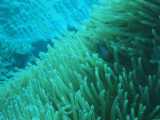 In the soft coral often fish can hide.
In the soft coral often fish can hide.
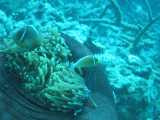 A couple of nice anemone fish in a complex constellation of soft coral. In the background antler coral.
A couple of nice anemone fish in a complex constellation of soft coral. In the background antler coral.
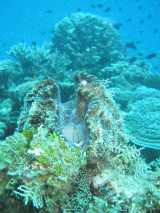 The Giant Clam has spots on the shell which act like eyes, they are sensible for light anyhow. If you come close, the giant
clam snaps to close with an incredible power. If the clam catch your hand or feet, you have a problem. Your last problem.
The Giant Clam has spots on the shell which act like eyes, they are sensible for light anyhow. If you come close, the giant
clam snaps to close with an incredible power. If the clam catch your hand or feet, you have a problem. Your last problem.
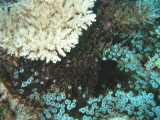 Fish is hiding in soft coral.
Fish is hiding in soft coral.
 Here we see a school of wrasses. Fish are not shy at all and only swim awy if you come very close.
Here we see a school of wrasses. Fish are not shy at all and only swim awy if you come very close.
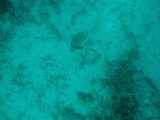 An angelfish, in deep water. In the deep the colours fade.
An angelfish, in deep water. In the deep the colours fade.
<
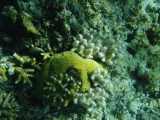 More to the surface the colours are more bright. Here nice coral, yellow spongue
More to the surface the colours are more bright. Here nice coral, yellow spongue
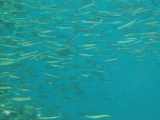 Sometimes you see big schools of Whitebait. these stay small and operate in big schools. The school turns and swirls like one big animal. This enhances the survivability.
Sometimes you see big schools of Whitebait. these stay small and operate in big schools. The school turns and swirls like one big animal. This enhances the survivability.
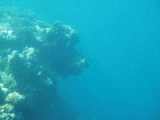 The coral forms vertical wall, bursting with life.
The coral forms vertical wall, bursting with life.
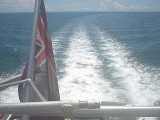 After the last dive we quickly leave for the coast again. We should be at the end of the afternoon in the harbour.
After the last dive we quickly leave for the coast again. We should be at the end of the afternoon in the harbour.
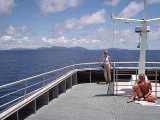 After packing our luggage and clearing the room we enjoy some time at the sundeck.
After packing our luggage and clearing the room we enjoy some time at the sundeck.
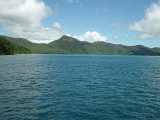 Our diving experience definitely was the highlight of this Australian tour. And the Advance Open Water diver qualification allows now to dive down to 30 meter.
Our diving experience definitely was the highlight of this Australian tour. And the Advance Open Water diver qualification allows now to dive down to 30 meter.
Sailing back was great as well. The trip
went along the Whitsunday Islands, fairy-tale islands with reefs as well, but close to the coast. Dolphins were playing around the ship and jumped high out of the water.
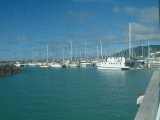 With some regret we say farewell to our diving friends, with whom we spend some wonderful days on this pretty boat.
With some regret we say farewell to our diving friends, with whom we spend some wonderful days on this pretty boat.
Scuba diving is so addictive, that selecting a dive destination will be part of the next travel plans.
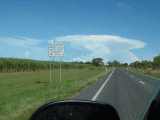 We travelled to the south directly after we arrived in the harbour. We have to travel south some 2000 km to Sydney and plan to do that in 6 days. But during this trip we have planned some nice events, like fossicking of “thundereggs” at Mount Hay. Later more about this. En route we see huge thunderstorms, marking a change in weather. In the evening we arrived again in the nice camping at St Helens. The layout there is very attractive, as lots of different types of palms are planted. The swimming pool we used after the morning run was nice cool.
We travelled to the south directly after we arrived in the harbour. We have to travel south some 2000 km to Sydney and plan to do that in 6 days. But during this trip we have planned some nice events, like fossicking of “thundereggs” at Mount Hay. Later more about this. En route we see huge thunderstorms, marking a change in weather. In the evening we arrived again in the nice camping at St Helens. The layout there is very attractive, as lots of different types of palms are planted. The swimming pool we used after the morning run was nice cool.
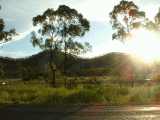 We are passing magnificent landscapes. Sometimes we take a picture of it.
Back in Mackay we bought a complete dive outfit, except the tank and the weight belt, which you always get at the dive centre. Hopefully it's not a problem with luggage overweight and the customs.
We are passing magnificent landscapes. Sometimes we take a picture of it.
Back in Mackay we bought a complete dive outfit, except the tank and the weight belt, which you always get at the dive centre. Hopefully it's not a problem with luggage overweight and the customs.
The trip to Rockhampton offered some nice scenery and spectacular cloud formations.
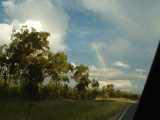 Once we saw a very bright coloured rainbow.
Once we saw a very bright coloured rainbow.
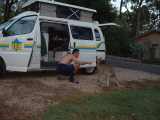 We ended the day at the Capricorn Caves, which had an excellent camping, be it that we were the only visitors. Or.... not the only, there were many kangaroos and wallabies as well, enjoying the fact that Australian people avoid this area in this hot summer. Apparently, only travellers from far like to survive these high temperatures.
We ended the day at the Capricorn Caves, which had an excellent camping, be it that we were the only visitors. Or.... not the only, there were many kangaroos and wallabies as well, enjoying the fact that Australian people avoid this area in this hot summer. Apparently, only travellers from far like to survive these high temperatures.
Though we are camping at the Capricorn caverns, we did decide not to have a tour here as we have seen much better ones.
We were the only guest at the camping, there were however some kangaroos roaming in the dusk.
 Next morning we woke up earlier, at 04.30, so we had more time for our program. In the dusk before sunrise the kangaroos came again and it did cost some time to become friends with them.
Next morning we woke up earlier, at 04.30, so we had more time for our program. In the dusk before sunrise the kangaroos came again and it did cost some time to become friends with them.
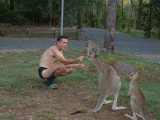 They seem to be used to humans. The adorable animals were really cute and one liked to be scratched behind his ears.
They seem to be used to humans. The adorable animals were really cute and one liked to be scratched behind his ears.
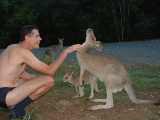 After some time even the young kangaroo liked to be friends.
After some time even the young kangaroo liked to be friends.
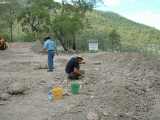 Next was a visit to Mount Hay, to fossick for thundereggs. We were again the only tourists there. It still is dead season and Australians avoid that area due to the high temperatures. These thundereggs are 120 million years old and formed in a complex way. In the fluid lava from an ancient volcano, gas bubbles formed cavities. Later the area was flooded and during million years the cavities were filled with mineral rich water. Molecule by molecule mineral crystals grown inside the bubbles and the lava reverted to rhyolite. This rhyolite was weathered to a clay-like substance and the bubbles with mineral crystals could be found in the ground.
Next was a visit to Mount Hay, to fossick for thundereggs. We were again the only tourists there. It still is dead season and Australians avoid that area due to the high temperatures. These thundereggs are 120 million years old and formed in a complex way. In the fluid lava from an ancient volcano, gas bubbles formed cavities. Later the area was flooded and during million years the cavities were filled with mineral rich water. Molecule by molecule mineral crystals grown inside the bubbles and the lava reverted to rhyolite. This rhyolite was weathered to a clay-like substance and the bubbles with mineral crystals could be found in the ground.
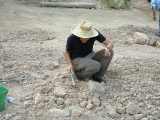 You were not allowed to go to the mine itself but the miner transported the material to an area where you could look for thundereggs. It was a nice experience.
You were not allowed to go to the mine itself but the miner transported the material to an area where you could look for thundereggs. It was a nice experience.
we got tools to work in the thunderegg containing soil and a bucket water to wash them.
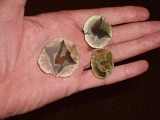 From the outside a stone, from the inside a surprise; you never
know what it contains until you cut it with a diamond saw. We found quite a lot of them and the nicest we had sawn open. Most of them were very nice. The size was usually an egg or smaller but often you find them in the size of an orange.
From the outside a stone, from the inside a surprise; you never
know what it contains until you cut it with a diamond saw. We found quite a lot of them and the nicest we had sawn open. Most of them were very nice. The size was usually an egg or smaller but often you find them in the size of an orange.
It was time to go further south. At this location we left the tropics again and could expect to enjoy cooler weather.
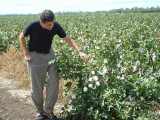 We choose the inland road, a long and winding road, passing through the Dividing Range with many stunning views. Arching over the landscape were huge thunderstorms which yielded torrential rains. It looked like a cold front and indeed the temperature dropped sharply to 32ºC Brrrrrrr.
We choose the inland road, a long and winding road, passing through the Dividing Range with many stunning views. Arching over the landscape were huge thunderstorms which yielded torrential rains. It looked like a cold front and indeed the temperature dropped sharply to 32ºC Brrrrrrr.
Sometimes you have a problem. Today we paused for a lunch on a nice place in the shadow, at the side of a junction with a dirt road. But upon departure, the car wheels were slowly sunk in, what proved to be, mud. No movement. We tried to fix it, by putting branches under the wheel and gravel, but it was just not enough. It was our lucky day as just at that moment a truck entered the dirt road. The muscled driver was so friendly to push us back on the road.
So far so good, but further an aggressive dog "attacked" our car. He overshot and was caught under the wheels of a heavy truck overtaking us. In the mirror I could see how in a red blur the dog exploded under the wheels. He never knew what hit him.
Near Belula we saw cotton fields still green with the cotton on it. Earlier we saw them with the pale green flowers.
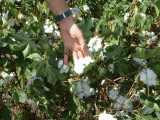 When the cotton balls are open, the plant will be sprayed dead, so the leaves will fall off. The picking machines can then harvest the cotton balls.
When the cotton balls are open, the plant will be sprayed dead, so the leaves will fall off. The picking machines can then harvest the cotton balls.
In the pouring rain we reached Gayndah, the citrus capital of Australia. The famous Gaypack (what's in a name!) mandarins are grown here. The last part of the trip it rained and in the night thunderstorms and lightning strikes kept us awake for a while. But it was a good sign, we were in the frontal system between hot and cooler weather.
Next morning the weather indeed has changed. It's cloudy and a cool 26ºC. So the morning run is very comfortable. However we decide to run up a lookout, the top of an old volcano. Running uphill does kill you indeed. We see many ants there. At the top we see thousand of bug wings scattered around. The bugs were attracted by a high-power light on the hill and died there. The ants are taking apart the bugs, but leave only one pair of wings, that seem of no use for them. Indeed we see everywhere ants dragging bug parts to their nests. Interesting to see how animals as well quickly can adapt to a high-tech man-made environment.
We have four days to go till we have to drop off our camper and still about 1600 kms to go. With regret we have to decide to ignore all the interesting things en route, but plan go to the coast south of Brisbane, as we did not see this part of Australia until now. It must be interesting, that moderate climate rainforest there. The landscape was nice. At first rolling later flat terrain and near Brisbane again steep hills. This was the first day that we could drive without air-conditioning. At first we had an overcast, later it was sunny again.
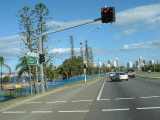 We passed Brisbane, as we spend there already some days, to go directly to the Goldcoast. This is the top coastal holiday area in Australia. The town is scattered with well maintained high apartment buildings and hotels, an impressive skyline. The beach must be too small to accommodate all the people in the apartments.
We passed Brisbane, as we spend there already some days, to go directly to the Goldcoast. This is the top coastal holiday area in Australia. The town is scattered with well maintained high apartment buildings and hotels, an impressive skyline. The beach must be too small to accommodate all the people in the apartments.
 The nightlife must be great here and if that's the way you like to spend your holiday, this is the place for you. We passed Surfers Paradise quickly and pass the most easterly point of Australia at Tweed Heads. Here is the largest caldera of the Southern Hemisphere, the Mt Warning Shield volcano. It remains from volcanic activities 20 million years ago.
The nightlife must be great here and if that's the way you like to spend your holiday, this is the place for you. We passed Surfers Paradise quickly and pass the most easterly point of Australia at Tweed Heads. Here is the largest caldera of the Southern Hemisphere, the Mt Warning Shield volcano. It remains from volcanic activities 20 million years ago.
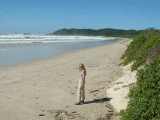 We ended the day in Byron Bay, a kind of backpackers beach resort, where we spend the night in a camping on the beach. The plan is to go to Coffs Harbour, 250 km south, to do some diving to test the new equipment. It seems to be great there, as here the northern warm sea water merges with the southern cold, but nutritious water. The sea must be full here of living creatures. But first, after breakfast we visited the beach. The camping was in the dunes and a few minutes we reached the beach. Nice sand, nice weather. On the beach were the footprints of kangaroos visible, very distinctive due to the big central toe. We had a nice run of 55 minutes on the wet sand and enjoyed that quite a lot, though it was real heavy.
We ended the day in Byron Bay, a kind of backpackers beach resort, where we spend the night in a camping on the beach. The plan is to go to Coffs Harbour, 250 km south, to do some diving to test the new equipment. It seems to be great there, as here the northern warm sea water merges with the southern cold, but nutritious water. The sea must be full here of living creatures. But first, after breakfast we visited the beach. The camping was in the dunes and a few minutes we reached the beach. Nice sand, nice weather. On the beach were the footprints of kangaroos visible, very distinctive due to the big central toe. We had a nice run of 55 minutes on the wet sand and enjoyed that quite a lot, though it was real heavy.
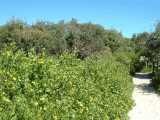 On the beach were many nice flowers with leathery leaves. Butterflies with blue and black patterns were abundant.
On the beach were many nice flowers with leathery leaves. Butterflies with blue and black patterns were abundant.
<
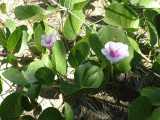 We picked some seeds from this nice plant. We hope it will grow well in our garden.
We picked some seeds from this nice plant. We hope it will grow well in our garden.
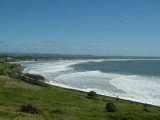 The trip to Coffs Harbour was nice, partly along the coast and we had on Lennox Lookout a nice view on a surf spot.
The trip to Coffs Harbour was nice, partly along the coast and we had on Lennox Lookout a nice view on a surf spot.
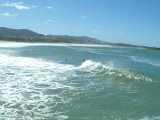 Indeed there were many surfers and a few were very good. Cool! Surfing is now as well on my list to learn it one day.
Indeed there were many surfers and a few were very good. Cool! Surfing is now as well on my list to learn it one day.
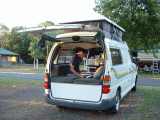 We are slowly approaching the end of the trip. We plan what we still can eat or throw away and start cleaning the car.
We are slowly approaching the end of the trip. We plan what we still can eat or throw away and start cleaning the car.
But we have some interesting things to go.
In the afternoon we wanted to arrange the diving trip for next day. But the dive centre told us that the waves were too big. There was no diving for the last week and at least for the remainder of this week. Hard luck! Maybe it's better south. We enjoyed the surfers, riding the waves on the beach of Coffs Harbour. This place is a sophisticated beach area, but unfortunately we had to go on. We ended up in Scotts Head.
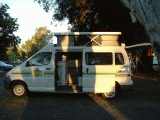 Scotts Head is a very scenic area at the coast, we spend there the night. The weather was excellent now. The temperature was in the higher twenties, but hot in the sun. Over the short-wave radio we hear that in Holland people were advised to stay home due to snow and freezing rain and that on the road chaotic circumstances prevailed......
Scotts Head is a very scenic area at the coast, we spend there the night. The weather was excellent now. The temperature was in the higher twenties, but hot in the sun. Over the short-wave radio we hear that in Holland people were advised to stay home due to snow and freezing rain and that on the road chaotic circumstances prevailed......
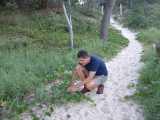 In the evening we make a nice walk, of course collecting some seeds.
In the evening we make a nice walk, of course collecting some seeds.
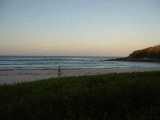 We enjoy the empty beaches and find some nice shells.
We enjoy the empty beaches and find some nice shells.
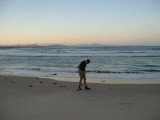 On the beach we find strange objects. Brown cylinders, if you stand on it, a jet of water comes out of it. probably a kind of seaweed or anemones.
On the beach we find strange objects. Brown cylinders, if you stand on it, a jet of water comes out of it. probably a kind of seaweed or anemones.
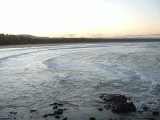 The last sun rays colour the sky yellow.
The last sun rays colour the sky yellow.
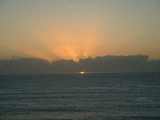 Next morning we had the opportunity to see the sunrise from the Pacific Ocean. We climbed in the dark a rock high over the coast. Unique was that there
was a layer of clouds just over the horizon.
Next morning we had the opportunity to see the sunrise from the Pacific Ocean. We climbed in the dark a rock high over the coast. Unique was that there
was a layer of clouds just over the horizon.
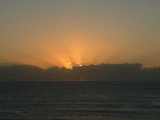 Unique was that there was a layer of clouds just over the horizon.
So we saw the sun as
a small slice rising above the horizon and
then in a cloud again
Unique was that there was a layer of clouds just over the horizon.
So we saw the sun as
a small slice rising above the horizon and
then in a cloud again
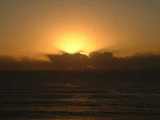 A few minutes later
the sun did rise over the cloud layer. It
was a nice view.
A few minutes later
the sun did rise over the cloud layer. It
was a nice view.
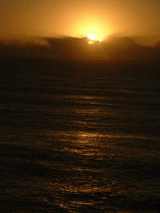 The sun did show like a firework, changing
every minute in spectacular light effects.
The sun did show like a firework, changing
every minute in spectacular light effects.
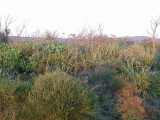 Shrubs at the top of the cliff are lighting up in the morning sun.
Shrubs at the top of the cliff are lighting up in the morning sun.
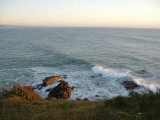 Walking back we see the morning sun skimming over the waves.
Walking back we see the morning sun skimming over the waves.
On the beach we found some nice and colourful sea shells, one of them a kauri shell, uses in nearby New Guinea as currency by the local population. After breakfast we had a nice run, over the beach again.
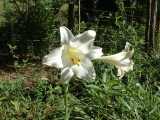 As here are no diving opportunities, we have to go further; maybe we find another area with suitable weather for scuba diving. Sad is however that we just left the area with corals. Coral is very sensitive for temperature, and not only that. You will find coral reefs all over the world only at the east side of continents, with just one exception, a reef near Perth. Often we see lilies, they can be 2 meter high. Of course we collect some seed. Along the road you see
very often big quantities of white lilies.
They may grow as high as 2 meters. We
collected some seedpods but as they are
rather green it is doubtful if they
germinate.
As here are no diving opportunities, we have to go further; maybe we find another area with suitable weather for scuba diving. Sad is however that we just left the area with corals. Coral is very sensitive for temperature, and not only that. You will find coral reefs all over the world only at the east side of continents, with just one exception, a reef near Perth. Often we see lilies, they can be 2 meter high. Of course we collect some seed. Along the road you see
very often big quantities of white lilies.
They may grow as high as 2 meters. We
collected some seedpods but as they are
rather green it is doubtful if they
germinate.
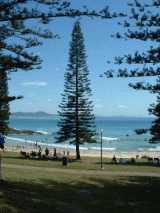 On our trip further south we cam in South West Rocks, a nice isolated beach town, with many aurecaria trees. These majestic trees look over a nice beach with huge surfs, many enjoying surfing. Here is a very interesting dive site, a cave through an island. You enter it through a chimney, 24m deep and then you cross the island. Unfortunately today and tomorrow no diving, as the waves are too high. Then further, they advised to go to Foster, there was a better chance.
On our trip further south we cam in South West Rocks, a nice isolated beach town, with many aurecaria trees. These majestic trees look over a nice beach with huge surfs, many enjoying surfing. Here is a very interesting dive site, a cave through an island. You enter it through a chimney, 24m deep and then you cross the island. Unfortunately today and tomorrow no diving, as the waves are too high. Then further, they advised to go to Foster, there was a better chance.
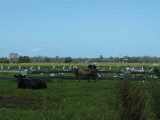 Everywhere we saw white birds near cows. Sometimes it looks like every cow has his own guard-bird. Here are a lot of them.
Everywhere we saw white birds near cows. Sometimes it looks like every cow has his own guard-bird. Here are a lot of them.
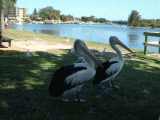 Next location to visit is Foster. It is located near big lakes and a premier holiday destination, and lots fish. We saw a fisherman killing an octopus, terrible that noises, but we were lucky to see a live one near the coast.
On the coast we saw a few pelicans, begging for food. They were not shy anymore.
Next location to visit is Foster. It is located near big lakes and a premier holiday destination, and lots fish. We saw a fisherman killing an octopus, terrible that noises, but we were lucky to see a live one near the coast.
On the coast we saw a few pelicans, begging for food. They were not shy anymore.
The good news was that tomorrow I can board a dive boat for two dives in the morning. They promised a perfect diving spot in the sea, so I can checkout the new diving gear.
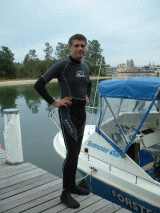 This fits perfect in our plan, so we can easily drive in the afternoon to Sydney, some 4 hours driving.
This fits perfect in our plan, so we can easily drive in the afternoon to Sydney, some 4 hours driving.
Next morning the divemaster said he watched the sea. Diving was this morning expected to be marginal. Bad visibility, high waves. Still we decided to go, but four divers chickened out. The small boat jumped over the waves and hit the water sometimes violent. Before we were at the dive spot, I start feeling the first signs of seasickness, so eyes fixed on the horizon or coast is the best remedy. The high waves were tricky, if you stayed close to the boat you might have been smashed against it. So going down as soon as possible was the advice. But there it was even worse, the current was very strong, you had to fight for every meter. And my new regulator seemed not to deliver enough air. In the murky dark water we still could see interesting fish, if they passed very close. We should stay close together, as the by the bad visibility there was a risk to loose the buddy. And without gloves hanging on to rocks and seaweed is no fun either. So I was glad to be back again at the surface.
But even if the circumstances were far from ideal, it was an interesting and challenging experience. That's part of diving as well.
The second dive I skipped and the other divers were happy to go back as well. Now I understand completely why all the dive centres in the north did not dive in the past week.
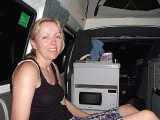 After the dive we travelled back to Sydney, first to the area where the camper had to be dropped off and then looking for a caravan park. According to the maps we had, here was no one and: this time the maps were correct. We had to drive for more than an hour to find one. Here we packed our bags and prepared the camper for delivery. A few others had comment that we cleaned the car and interior, but we drop off the car, like we got him.
After the dive we travelled back to Sydney, first to the area where the camper had to be dropped off and then looking for a caravan park. According to the maps we had, here was no one and: this time the maps were correct. We had to drive for more than an hour to find one. Here we packed our bags and prepared the camper for delivery. A few others had comment that we cleaned the car and interior, but we drop off the car, like we got him.
Though it looks like a small trip on the map, we travelled more than 5000 kilometers. We travelled at ease and had no real problems. Thraffic in Australia is safe and motorist behave excellent. You can see that few cars have dents. Australians love their vehicle and they care for it.
A little sad we went to the airfield on our way to cold and winterly Europe. Time went too fast. The people are so relaxed and the country so interesting. We love Australia and sure we will be back soon.
The flight back went not without problems. Though the luggage was labelled through Amsterdam, you have to retrieve the luggage in the USA in San Francisco, and directly deliver back again, so they can check it again and again. The security checks on persons are now so tight that the alarm is beeping on the fillings of your teeth! But you get used to the routine of stripping yourself of every piece of metal.
When the check-in of the connecting flight started, we still were waiting at for our luggage. When we got it at last, we had to run for some kilometres to the domestic airport the flight to Chicago. We were too late, but the good news was that the aircraft had a delay of an hour. The bad news however was that the connecting flight in Chicago had no delay, so we would miss that flight. Now we were booked to London and then to Amsterdam. To catch the plane for London we had to run fast back to the international terminal. With all the luggage in the arms we slalommed at high speed through the passenger crowds. It must have been a funny sight, but now we got our daily training at least. But we made it, as the last passengers boarding the plane. The Jumbo got immediately after that the push-back from the jetty, but it returned again as they had not enough meals on board (our meals?).
After one hour we left again the jetty for the long trip to London. The rest of the trip was uneventful.
Of course the luggage was missing after these changes, but we were lucky that it was delivered home after 2 days. And that saved us some dragging around with it. We went with 6 kg, and returned with 20kg.
The Customs were not there, so that saved us some explanation about that fortune of precious stones and the new divegear.
Back in Almere it took some time to get back to normal routine. Birgitt was sad, still with her thoughts on that marvellous trip, and liked to go back.
Yes, we are real Australia lovers.
And true love will never die.
Back to the Top
The harbour is an interesting area, vistited by many.
Adjacent to the Opera House, is the Botanic Garden, very interesting. An enormous variety of plants and trees can be seen, the climate allows for almost any species. Tropical species are exhibited in a nice green house. Most plants are good described and much background information is available, so it's a good opportunity to refresh the study biology.
We were greeted by two Australian White Ibis Threskiornis molucca.You see them often. It is a large, white wading bird with a naked, black neck and it has a long, downcurved bill.
We come close again near a white Ibis. This animal is here not too shy.
It was fired by coal, mined directly near the power station. The coal seams are 300m deep, thick and high quality, with a low sulphur content. The coal is blown as fine powder is the heater. Two generators of each 660 Mw supply the power. It is a high technology power station, but the management is well aware of the environmental impacts and try to cope with that. The company has 4 power stations and supplies 20% of the liberalised Australian power market. An exhibition showed that alternative power sources like wind, sun and biomass, how sympathetic they may be, only can fulfil a minimal role in the power generation based on the present demand.
From the eastern side of the Gread Dividing ridge, we have a nice view over the Blue Mountains. They are called that way, as a blue haze is visible, due to the eucalyptus trees which emit their fragrance. It smells nice and fresh.
First was explained how the operations of this day would go, all of us got a task.
On the beach we find strange objects. Brown cylinders, if you stand on it, a jet of water comes out of it. probably a kind of seaweed or anemones.